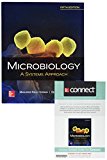
Concept explainers
Both flagella and cilia are found primarily in
- a. algae.
- b. protozoa.
- c.
fungi . - d. both b and c.
Introduction:
Flagella are a whip-like construction that helps in the movement of bacteria. Their main purpose is to make bacteria swim over fluid. It is like a rotator device which makes revolution per second like in Trypanosoma. Cilia are a tiny hair-like structure that is present on the surface of the cell. Cilia help in the movement of the cell.
Answer to Problem 1MCQ
Correct answer:
Both flagella and cilia are found primarily in protozoa. Therefore, option (b) is correct.
Option (b) is given as “protozoa”.
Explanation of Solution
Justify the reasons for the correct statement:
The protozoan is the term given to single-celled eukaryotes. So, in this group, all the organisms are clustered who have flagella and cilia. In the group of protozoa, amoeba and euglena are included.
Hence, option (b) is correct.
Justify reasons for the incorrect statements:
Option (a) is given as “algae”.
Algae are simple eukaryotic organisms that possess chlorophyll that act as a primary photosynthetic pigment which lacks a sterile covering of cells around the reproductive cells. Hence, it is a wrong answer.
Option (c) is given as “fungi”.
Fungi are the member of a eukaryotic organism that can digest food from outside and absorb the nutrients through their cell wall. Hence, it is a wrong answer.
Option (d) is given as “both band c”.
Protozoa have both flagella and cilia but fungi did not have either flagella or cilia. Hence, it is a wrong answer.
Hence, options (a), (c), and (d) are incorrect.
The protozoan is the group of organisms that have both flagella and cilia. Protozoan includes all the unicellular eukaryotes.
Want to see more full solutions like this?
Chapter 5 Solutions
GEN COMBO LOOSELEAF MICROBIOLOGY:A SYSTEMS APPROACH; CONNECT ACCESS CARD
- What did the Cre-lox system used in the Kikuchi et al. 2010 heart regeneration experiment allow researchers to investigate? What was the purpose of the cmlc2 promoter? What is CreER and why was it used in this experiment? If constitutively active Cre was driven by the cmlc2 promoter, rather than an inducible CreER system, what color would you expect new cardiomyocytes in the regenerated area to be no matter what? Why?arrow_forwardWhat kind of organ size regulation is occurring when you graft multiple organs into a mouse and the graft weight stays the same?arrow_forwardWhat is the concept "calories consumed must equal calories burned" in regrads to nutrition?arrow_forward
- You intend to insert patched dominant negative DNA into the left half of the neural tube of a chick. 1) Which side of the neural tube would you put the positive electrode to ensure that the DNA ends up on the left side? 2) What would be the internal (within the embryo) control for this experiment? 3) How can you be sure that the electroporation method itself is not impacting the embryo? 4) What would you do to ensure that the electroporation is working? How can you tell?arrow_forwardDescribe a method to document the diffusion path and gradient of Sonic Hedgehog through the chicken embryo. If modifying the protein, what is one thing you have to consider in regards to maintaining the protein’s function?arrow_forwardThe following table is from Kumar et. al. Highly Selective Dopamine D3 Receptor (DR) Antagonists and Partial Agonists Based on Eticlopride and the D3R Crystal Structure: New Leads for Opioid Dependence Treatment. J. Med Chem 2016.arrow_forward
- The following figure is from Caterina et al. The capsaicin receptor: a heat activated ion channel in the pain pathway. Nature, 1997. Black boxes indicate capsaicin, white circles indicate resinferatoxin. You are a chef in a fancy new science-themed restaurant. You have a recipe that calls for 1 teaspoon of resinferatoxin, but you feel uncomfortable serving foods with "toxins" in them. How much capsaicin could you substitute instead?arrow_forwardWhat protein is necessary for packaging acetylcholine into synaptic vesicles?arrow_forward1. Match each vocabulary term to its best descriptor A. affinity B. efficacy C. inert D. mimic E. how drugs move through body F. how drugs bind Kd Bmax Agonist Antagonist Pharmacokinetics Pharmacodynamicsarrow_forward
 Concepts of BiologyBiologyISBN:9781938168116Author:Samantha Fowler, Rebecca Roush, James WisePublisher:OpenStax College
Concepts of BiologyBiologyISBN:9781938168116Author:Samantha Fowler, Rebecca Roush, James WisePublisher:OpenStax College
 Biology (MindTap Course List)BiologyISBN:9781337392938Author:Eldra Solomon, Charles Martin, Diana W. Martin, Linda R. BergPublisher:Cengage Learning
Biology (MindTap Course List)BiologyISBN:9781337392938Author:Eldra Solomon, Charles Martin, Diana W. Martin, Linda R. BergPublisher:Cengage Learning Biology: The Dynamic Science (MindTap Course List)BiologyISBN:9781305389892Author:Peter J. Russell, Paul E. Hertz, Beverly McMillanPublisher:Cengage Learning
Biology: The Dynamic Science (MindTap Course List)BiologyISBN:9781305389892Author:Peter J. Russell, Paul E. Hertz, Beverly McMillanPublisher:Cengage Learning





